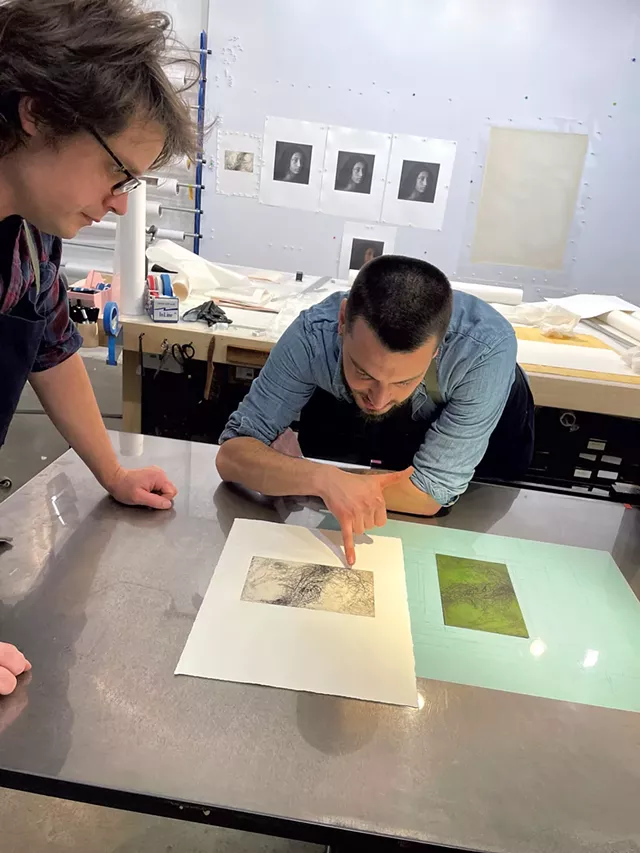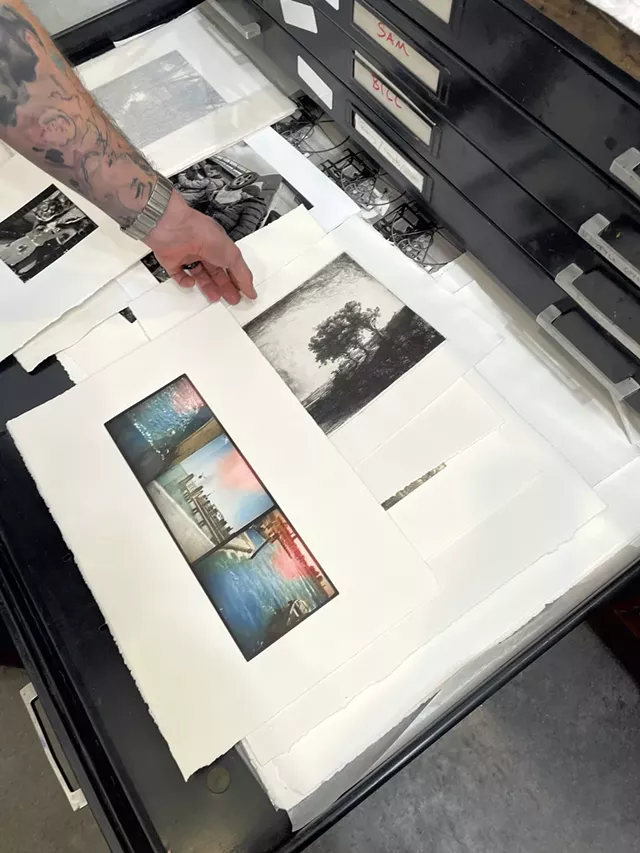In a weathered barn at the end of a dirt road on the side of a mountain in Cabot, there is a gleaming room with thick white walls, built as a walk-in cooler. Until recently, it was stacked floor to ceiling with cabbages and potatoes. These days, it holds huge printers, an etching press and luscious inks.
This is Prints on Paper Studio, a fine art printing service launched last August by artists Walker Blackwell, 41, and Nathanael Kooperkamp, 35. Blackwell is a photographer with extensive experience in high-end digital printing. Kooperkamp has a background in printmaking, papermaking and book arts. The two met while working at Cone Editions Press in East Topsham, which has been making fine art prints since the 1980s.
Though Prints on Paper is a new shop with a youthful vibe, being “in the middle of nowhere,” as the owners put it, allows them to take their time and focus on the artist-client relationship. Rather than simply offering print services, they are finding ways to collaborate with other artists and to treat their remote location as a destination. “We saw that as being the appeal,” Kooperkamp said. They are banking on a hybrid strategy — both in printmaking and in their wider approach to running a niche fine art venture.
Blackwell, who lives in Plainfield, grew up on the farm. His parents had several businesses — most recently, Blackwell Roots Farm, which produced sauerkraut and kimchee. When he was a kid, Blackwell said jokingly, it was a pansy farm, “but you don’t say that when you’re growing up in the middle of Cabot in the ’80s and ’90s.”
Kooperkamp was born in New York City but often visited his grandparents’ house in Corinth. He always knew he wanted to end up in Vermont, he said. He moved to Vershire in 2017.
The pair considered setting up shop in a busier metropolis, such as oh-so-urban Montpelier. But then Blackwell’s father, who retired from farming in 2019, offered them space in his barn. They realized it was perfect: It had room for future expansion and a small farmhouse for artists to stay on-site. There was even a pallet loader, which they used to install the 2,400-pound etching press they picked up, with help from a friend’s tractor, in New York.
Both artists gained experience and connections outside Vermont — Blackwell in Chicago and Kooperkamp in Brooklyn — long before they launched the Cabot studio. Blackwell became known in photography circles for pioneering digital print processes that result in monochromatic ink-jets indistinguishable from traditional silver gelatin prints.
Prints on Paper has recently produced high-end ink-jets for photographers such as celebrated photojournalist James Nachtwey, who lives in Hanover, N.H. Calais photographer Andreas John printed his project “The Many Voices of Water” at the shop. Its dreamy scenes of light-dappled streams and long-exposure shots of flowing creeks have a range of values much closer to an Ansel Adams print than anything out of a typical Epson printer. In an email, John said he trusts the shop completely and called Blackwell “one of the best printmakers in the country.”
Blackwell and Kooperkamp have also developed a new process for photogravure. What once took days of trial and error — exposing copper plates and etching them in acid — can now be accomplished in minutes using photopolymer plates and a nontoxic process. The finished prints have a deep, rich tonality. The thick paper gives them the air of works from a century ago but with the sharpness and clarity of something new.
When Seven Days visited Prints on Paper, the pair were printing photogravures by two different artists. Blackwell would hand a plate to Kooperkamp, who’d slather it with thick carbon black ink, then gently wipe off the excess. He’d pass it back to Blackwell, who’d trim a piece of 1970s vintage kozo paper, resting it over the image before aligning it on the press with a thick sheet of damp paper, then rolling and pulling a perfect chine collé print.
As we talked, they pulled prints for an edition of 18 by Guatemalan artist Luis González Palma, whom Blackwell met 20 years ago through a Chicago gallery. (An edition is a limited set of identical prints, individually numbered by the artist; no others printed that way or at that size can be sold, preserving each print’s value.) The works are haunting portraits of a young woman, micro-lines in the etching creating dimension in her hair and face. Once the prints are ready, they’ll be shipped off and signed by the artist. Half will return to Cabot to be sold directly by Prints on Paper, either online or at fairs such as the Brooklyn Fine Art Print Fair.
That day, Kooperkamp and Blackwell were also printing an edition by Tom Lawrence, an artist and retired neurosurgeon from Urbana-Champaign, Ill. Lawrence came to Cabot for a 10-day residency last fall, staying just across the dirt road in the farmhouse. Artists pay for residencies, as well as workshops to learn specific techniques, with rates depending on the length of stay; workshops are generally $450 per day. Lawrence, whose work centers on the Holocaust, would wake up early, opening the shop at 3 a.m., the printmakers joining him hours later. He started experimenting with photogravure, bringing plates outside to expose in the sunlight. He laid hair and ashes directly onto the plate and used a blowtorch on them, creating something almost sculptural.
“It started breaking apart the texture of the plate,” Kooperkamp said. “You cannot remake those marks in any way.”
Some artists simply come and print on-site with Kooperkamp and Blackwell, creating an entire exhibition in a day. Both value that collaborative approach, which they say is inherent to printmaking. Because each artist works differently, Kooperkamp said, “you just get to do a lot of weird, awesome things.”
Neither printmaker has had a lot of time for his own artwork lately. In addition to setting up the shop, both Kooperkamp and Blackwell have had new babies in the past year. Blackwell offered one example of his own recent photography — a print of muddy tire tracks in his neighbor’s yard, taken after Plainfield’s 2024 flood.
In certain respects, Prints on Paper is not so different from the farmers who occupied the space before it, relying on diversification — producing print editions and offering workshops and residencies instead of kimchee and pansies — to maintain a successful business. So far, their outfit seems to be working: Both artists recently put themselves on payroll.
The art world also has seasons, Kooperkamp said: “You’ll get really cold for a bit, and all of a sudden you get a phone call that changes your life. You kind of need to be ready for both at the same time.”


